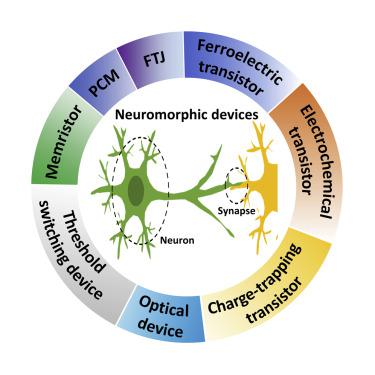iScience ( IF 4.6 ) Pub Date : 2020-11-24 , DOI: 10.1016/j.isci.2020.101846 Min-Kyu Kim , Youngjun Park , Ik-Jyae Kim , Jang-Sik Lee

|
Neuromorphic devices and systems have attracted attention as next-generation computing due to their high efficiency in processing complex data. So far, they have been demonstrated using both machine-learning software and complementary metal-oxide-semiconductor-based hardware. However, these approaches have drawbacks in power consumption and learning speed. An energy-efficient neuromorphic computing system requires hardware that can mimic the functions of a brain. Therefore, various materials have been introduced for the development of neuromorphic devices. Here, recent advances in neuromorphic devices are reviewed. First, the functions of biological synapses and neurons are discussed. Also, deep neural networks and spiking neural networks are described. Then, the operation mechanism and the neuromorphic functions of emerging devices are reviewed. Finally, the challenges and prospects for developing neuromorphic devices that use emerging materials are discussed.
中文翻译:

用于神经形态设备和系统的新兴材料
由于神经形态设备和系统在处理复杂数据方面的高效率,因此已成为下一代计算的关注点。到目前为止,已经使用机器学习软件和基于互补金属氧化物半导体的硬件对它们进行了演示。但是,这些方法在功耗和学习速度上都有缺点。节能的神经形态计算系统需要可以模仿大脑功能的硬件。因此,已经引入了各种材料来开发神经形态装置。在此,回顾了神经形态装置的最新进展。首先,讨论了生物突触和神经元的功能。此外,还描述了深度神经网络和尖峰神经网络。然后,回顾了新兴设备的运行机制和神经形态功能。











































 京公网安备 11010802027423号
京公网安备 11010802027423号